Initial Impressions of Bullet Journaling
It must be about 10 years ago that I first saw images of what people were calling bullet journals. But I didn’t know much about the method at the time, only what I saw images of, and to me it looked like art journaling, which didn’t interest me at the time. I was looking for a planner system I could live with, and all those fancy forms of bullet journals people were coming up with seemed to take a lot more time than I wanted to invest, so I stuck with pre-printed calendars and planners for a while longer.
Planners in General
The types of planners I used in the past varied from the simplest style of flip-page desktop calendar, on which I tracked jobs as a technical writer, and the little pocket calendars that banks used to hand out for free for my personal appointments, to more elaborate systems like the Franklin Covey (FC) system provided to me by my work organization when I became a supervisor in a busy, high-stress environment, and I suddenly had a lot more work-related things to keep track of. I had never used a formal planning system before then, and with it I went from occasionally sitting bolt upright in bed in the middle of the night wondering if I had done such-and-such, to sleeping better and rarely forgetting to do anything important. Using a planner saved me, in that kind of a job.
Later, after I retired, I found I still had a lot more to keep track of than I expected I would in retirement. So I went back and forth, from Franklin Covey to basic calendars, to slightly more involved calendars like the Exacompta Quo Vadis Space 17. But I never felt satisfied. Either I wasn’t using my full-on pre-printed planner daily, so there was a lot of waste, and I felt I was paying too much for a system I didn’t utilize to its fullest; or the simplicity of a calendar was too basic to track everything I wanted to. I wound up with to-do lists scattered in different formats, and a calendar that was sometimes empty and sometimes too full and jumbled for me to feel at ease with it. From time to time I tried printing my own planner, but even those never really seemed to work for me. Again there was waste, expense (it’s actually more expensive to print things in your own printer than to buy them already printed, in many cases), and a constant level of dissatisfaction, as well as feelings of inadequacy.
I did find one type of weekly calendar that I liked and used for years, first a weekly planner from Brush Dance Publishing, and later more streamlined weekly calendars in brands like Tullofa and Maalbok, both available from Amazon. They were almost what I was looking for, but I still found a need to keep separate to-do lists, and my to-do lists and project plans seemed to be, again, all over the place.
Sometime in 2021, I came across more information about bullet journaling, this time including Ryder Carroll’s original system, and references to his book, The Bullet Journal Method. I finally realized a bullet journal, in its simpler form, might be exactly what I needed.
Why a Bullet Journal?
Now that I understand what bullet journaling is, from its original source, the biggest draw for me is that it can be customized to fit me, the user, to meet my own specific needs, from simple to complex. And yes, if one wants to be artistic with it, one can. That’s entirely up to the user. But that’s not what makes the bullet journal useful for me. I do love to dabble in artwork, and even keep a visual journal from time to time, but the bullet journal primarily provides me a planner that I can tailor to my needs, and that is its greatest strength. I don’t personally care to combine my artwork and my planning.
The bullet journal is an incredibly versatile system. One can use an expensive dot journal, and all kinds of markers and even paint in their bullet journal, yes. But one can also keep a bullet journal simply and inexpensively, with a simple lined notebook and a pen.
My personal bullet journal has evolved over the past year-and-a-half. The way I now have mine set up, it’s incredibly easy to set up and use, and not at all wasteful of space. I use a low-cost graph paper notebook, and with my current method I can stretch one inexpensive notebook to make it last me a full year and still be versatile and useful.
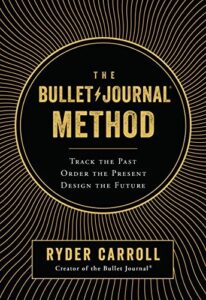 Ryder Carroll’s book, The Bullet Journal Method, sets forth the original bullet journal system, how he came up with it, and how it works, and it’s a truly comprehensive system, because you can tweak it to fit your life. It’s brilliant. I’d already started a bullet journal on my own, in an old spare notebook, basing it on tips I found online, when I began reading his book, but the book has the whole original system, with examples, and at the same time encourages the user to make it their own. It’s an excellent book, and goes into the why of journaling and directing our own lives, in some deep and thoughtful ways.
Ryder Carroll’s book, The Bullet Journal Method, sets forth the original bullet journal system, how he came up with it, and how it works, and it’s a truly comprehensive system, because you can tweak it to fit your life. It’s brilliant. I’d already started a bullet journal on my own, in an old spare notebook, basing it on tips I found online, when I began reading his book, but the book has the whole original system, with examples, and at the same time encourages the user to make it their own. It’s an excellent book, and goes into the why of journaling and directing our own lives, in some deep and thoughtful ways.
The basic information needed to begin a bullet journal is easy to find on Ryder Carroll’s YouTube channel. But I highly recommend reading his book.
There are blog articles on his website that bring in ideas from others, such as the Alastair Method and the Calendex, and numerous other ways that people have found to make bullet journals more useful to them (see links below). There seem to be endless possibilities. I’ve found lots of variety in how others bullet journal, that they’ve shared on YouTube, on blogs, and in groups on Facebook. All it takes is a few searches online to realize that the possibilities are infinite. I’ll share a few more links at the bottom of this post.
How I Bullet Journal
I began my first bullet journal in September, 2021, and back then I went through a period of looking at lots of ways of keeping a bullet journal, studying what others did and trying different things. That first bullet journal was where I experimented in lots of ways. But this year, after nearly a year-and-a-half of experimenting, I found that I had settled into a simple, easy-to-maintain system that works for me. It’s pretty basic, and yet tailored to my current needs.
My own bullet journal system started out more complicated than it is now, and I made it even more so as I went through that experimentation period, until finally it became too much for me and I realized I needed to take a step back and simplify it down to bare bones. Which is fine, because the system allows you to do that fairly easily, especially if you’re not someone who likes to set up your whole planner for the year ahead of time, but work in a linear fashion from the beginning of a notebook to the end.
Materials I Use
The links provided to materials in the following list are not necessarily where I bought them, and are not affiliate links, but they have useful information about the products.
- Exacompta Forum notebook – these come in three formats but I use the graph paper version, which has a 5×5 mm grid – UPDATE as of 2/8/2024, this journal appears to no longer be available.
- Uni-ball Signo DX pen 0.38 – this is an extra fine-point pen that allows for smooth, small writing – I have black and red ink colors (actually I have a lot of colors, but those are the two I use in my bullet journal)
- Zebra Mild Liner highlighters various colors – I use these to highlight the dates of my entries for visibility
- washi tape 15 mm wide – ordinary masking tape would work fine
- Post-It sticky notes – in size 1-1/2″ x 2″ also useful as bookmarks
- cutouts from a printable calendar I found for free online
- Scotch tape
- Tombow Mono Correction Tape
That’s it. Most of these materials after the first three I use only occasionally. I don’t even find it necessary to use a ruler to draw lines. But then I’m not reaching for perfection, only for practical, streamlined planning. I don’t care if my lines are a little squiggly. I do have a nice cover I had previously purchased for a more diary-like Exacompta Forum notebook. But my graph paper version fits inside the cover just fine, and I found other uses for the notebook that came with the cover. I’ve purchased my materials online, mostly from Amazon, as well as a couple items from Jetpens, and one other source, Classic Office Products. Some are things I had on hand already, such as the Post-It notes and highlighters.
But you don’t even need to go this far to try out bullet journaling. All it really takes is any ordinary notebook and a pen. For how to set up an ultra-simple bullet journal in any lined notebook, see the video in link 8, at the bottom of this post.
Bullet Journal Setups I Use
Right now, I don’t use an index, though I’ve left a few pages blank in the front of my current notebook in case I need to go back and add one. I only have monthly logs, all in their own section, a daily task/habit list for each month, sleep and weight charts for each month, and my daily pages. I’ve set up each of these as sections in my notebook, so I don’t really need an index, only to separate the sections with tabs made from washi tape. I use small Post-It notes to mark my current place in each section. I number the pages as I go along, usually about 50 pages in advance. I’m including images of my format, though I have edited out any personal information, as these are just to give an idea of what my bullet journal looks like and how it works.
Your bullet journal, if you happen to decide to use one, will of course reflect you, your life, your needs and it could be quite different from mine. Maybe you like really straight lines and want to use a ruler to draw them. Maybe you want a larger grid, or a dot grid, so you would prefer another brand of notebook. Maybe you want your bullet journal to be artistic, an expression of your creativity as well as your tasks and plans. Great! I’m not trying to tell anyone to keep a bullet journal, or how to keep one, only why I use one and what works for me.
The images below can be enlarged by clicking on them. They’ll open in a new tab.
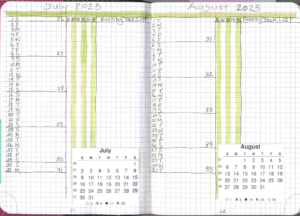 Monthly Logs — pages 5-16
Monthly Logs — pages 5-16
In the beginning of my bullet journal, I have laid out the entire year, one page per month. I’ve divided each month’s page into two columns. One is a vertical calendar where I can enter future appointments and events. The other column is a running task list for things that must be done that month. I’ve taped in a cutout calendar from a free printable one I found online. I just like that visual format for reference, as well as the moon phases. But it isn’t necessary.
Daily Task List for Each Month — pages 17-40
Each page here is a monthly calendar on one axis with a list of tasks on another axis, things I need to either remember to do or remember when I last did them, or new habits I want to acquire. I tick off the ones I did each day. I deliberately blocked my tasks out of this image, for privacy reasons, but some suggestions for tasks or habits to include here could be:
- feed cats AM
- freshen cat water
- feed cats PM
- trashes (the night before trash day)
- exercise
- laundry
- vacuum (or another cleaning task)
- pay bills
- shop
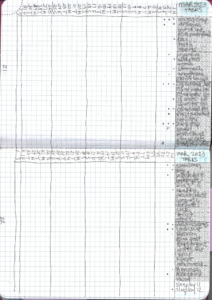 Some of mine are reminders of things I need to do daily or weekly. Some are habits I want to make part of my life. Others are records of when something got done. I even have a line right now for when a pen runs out of ink, because I’m trying to figure out how many ink refills to keep on hand for a particular period of time. I track when we treat the cats for fleas, and when we open a new bag of dry pet food. This helps me plan future purchases, and feeds into my budget planning.
Some of mine are reminders of things I need to do daily or weekly. Some are habits I want to make part of my life. Others are records of when something got done. I even have a line right now for when a pen runs out of ink, because I’m trying to figure out how many ink refills to keep on hand for a particular period of time. I track when we treat the cats for fleas, and when we open a new bag of dry pet food. This helps me plan future purchases, and feeds into my budget planning.
Each month I review what I tracked on these pages last month, and whether that still seems relevant. For that reason, I only set up one month at a time.
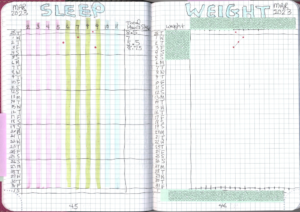 Sleep Chart and Weight Chart for Each Month — pages 41-64
Sleep Chart and Weight Chart for Each Month — pages 41-64
These are on facing pages, the sleep chart on the left and the weight chart on the right. I track my sleep hours, mainly because I have problems getting enough sleep, and this way I can track my progress improving my sleep pattern. The weight chart is a carryover from my weight loss regimen of May 2021-March 2022, when I lost about 60 pounds. I continue tracking my weight daily so I know how I’m doing keeping off the weight I lost.
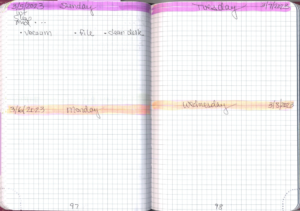 Daily Pages — pages 65 through the remainder of the notebook (373 useful pages total)
Daily Pages — pages 65 through the remainder of the notebook (373 useful pages total)
Most days, I use half a page, but on a very busy day I might use a full page — and I might now and then use more than a full page, but that hasn’t happened yet this year. This is where the rubber meets the road. It’s the most important aspect, for me, of my bullet journal. It’s where I make plans, track projects, track tasks, track what I read, accomplish, need to work on, and how I’m spending my time. For me it’s fairly informal and simple. I use a bullet for a task to do, and x it out when I do it, or use a > when I migrate it forward, a dash for a note, and a small circle for events, just as in the original bullet journal method.
I rarely set these pages up in advance (although I did for this example), because I want to allow myself as much space as I need, while doing my best to keep it to a half-page per day. For each day I highlight two lines, and that’s where I write the day of the week in the center and the day’s date in the outer edge of the page. That makes it easy for me to locate a particular date if I need to refer back.
The beauty of my current system is that it’s not set in stone. I can easily add elements and change it, if something new comes up in my life that I need to keep track of. Or I can make it even simpler.
Where My Bullet Journal Might Go From Here
The sky’s the limit, I suppose. I might decide, for instance, that I want to block out hours in my day, or keep weekly logs again, as I did when I started. I found them useful back then, but eventually I found I stopped using them, so I stopped setting them up. I used to organize the journals with a year’s calendar, and then each month as a section with weeklies and dailies, before the next monthly page. But I find the way I’ve sectioned my journal this year to be more practical for me — at this time. And that’s the beauty of the bullet journal, it can change as my life or needs change. Two years from now I could have a completely different looking bullet journal. There really are no rules, only suggestions and guidelines.
Links to More About Bullet Journals
I may come back and add even more links to this article later, so if you are interested in bullet journaling tips, check back now and then.
- https://bulletjournal.com/blogs/bulletjournalist
- Future Log: The Alastair Method (bulletjournal.com blog post)
- To Do: The Alastair Method (bulletjournal.com blog post)
- Plant Based Bride: BuJo 101 The Rolling Weekly (YouTube video)
- The Petite Planner: How To Use a Running To Do List in Your Bullet Journal (blog post)
- JashiiCorrin: My Favourite BUllet Journal Hack – The Alastair Method (YouTube video)
- Future Log: The Hope Method – Calendex (bulletjournal.com blog post)
- MenWhoBullet: How To Use The Bullet Journal Method In Any Notebook (YouTube video)
I hope this post is useful to you, especially if you’re considering starting a bullet journal or are dissatisfied with the planners available to you. I’d be happy to hear from you with questions or about your own bullet journaling experience, and of course I also recommend going to the original source, Ryder Carroll, via his book, his website and/or his YouTube channel. Please feel free to comment below, and Happy Journaling!